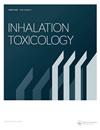肝脏转录组分析揭示了高氨暴露的生物学途径和转录因子
IF 2
4区 医学
Q4 TOXICOLOGY
引用次数: 1
摘要
摘要目的:氨是一种有毒气体,吸入后不仅会污染环境,还会危害人体健康。肝脏是一个重要的解毒器官,可以将外界或代谢的有毒物质转化为无毒物质。然而,氨暴露对肝脏的毒性作用尚未得到很好的研究。方法:本研究以猪为动物模型,暴露于80 ppm氨(8 12小时 天),然后进行RNA-seq以探索对肝脏中高氨暴露的反应的关键基因。结果:基因集富集分析(GSEA)显示,氨组与缺氧、炎症反应和细胞凋亡相关的基因上调,但与DNA复制、亚油酸代谢和糖酵解相关的基因下调。暴露组和对照组共鉴定出556个差异表达基因(DEG),其中包括54个编码转录因子(TF)的基因。GO和KEGG通路分析表明,这些DEG参与炎症反应、氧化应激、细胞凋亡、免疫和细胞周期。此外,TF-靶标相互作用分析表明,FOS、HIF-1α、JUNB、ATF3、REL和KLF4是调节高氨暴露时肝脏基因表达的重要TF。结论:总之,我们的研究结果不仅提供了高氨暴露后肝脏的mRNA转录组图谱,而且还发现了一些关键基因和转录因子,可用于研究高氨对肝脏的毒性机制。本文章由计算机程序翻译,如有差异,请以英文原文为准。
Liver transcriptome analysis reveals biological pathways and transcription factors in response to high ammonia exposure
Abstract Aim: Ammonia is a toxic gas that not only causes environmental pollution, but also is harmful to human health after inhalation. Liver is an important detoxification organ that can convert external or metabolized toxic substances into nontoxic substances. However, the toxic effects of ammonia exposure on livers have not been well studied. Method: In this study, pigs were used as an animal model and were exposed to 80 ppm ammonia (8 h during 12 days), and then, RNA-seq were conducted to explore the key genes in response to high ammonia exposure in livers. Result: Gene set enrichment analysis (GSEA) showed that the genes associated with hypoxia, inflammatory response, and apoptosis were up-regulated in the ammonia group, but the genes associated with DNA replication, linoleic acid metabolism, and glycolysis were down-regulated. Totally, 556 differentially expressed genes (DEGs) including 54 genes that encode the transcription factors (TFs) were identified between the exposure and control groups. GO and KEGG pathway analysis suggested that these DEGs were involved in inflammatory response, oxidative stress, apoptosis, immune, and cell cycle. Furthermore, the TF-target interaction analysis showed that FOS, HIF-1α, JUNB, ATF3, REL, and KLF4 were important TFs in regulating the hepatic gene expression in response to high ammonia exposure. Conclusion: Altogether, our findings not only presented a comprehensive mRNA transcriptome profile of liver after high ammonia exposure, but also found some key genes and TFs that could be used to investigate the toxicity mechanism of high ammonia on livers.
求助全文
通过发布文献求助,成功后即可免费获取论文全文。
去求助
来源期刊

Inhalation Toxicology
医学-毒理学
CiteScore
4.10
自引率
4.80%
发文量
38
审稿时长
6-12 weeks
期刊介绍:
Inhalation Toxicology is a peer-reviewed publication providing a key forum for the latest accomplishments and advancements in concepts, approaches, and procedures presently being used to evaluate the health risk associated with airborne chemicals.
The journal publishes original research, reviews, symposia, and workshop topics involving the respiratory system’s functions in health and disease, the pathogenesis and mechanism of injury, the extrapolation of animal data to humans, the effects of inhaled substances on extra-pulmonary systems, as well as reliable and innovative models for predicting human disease.
 求助内容:
求助内容: 应助结果提醒方式:
应助结果提醒方式:


